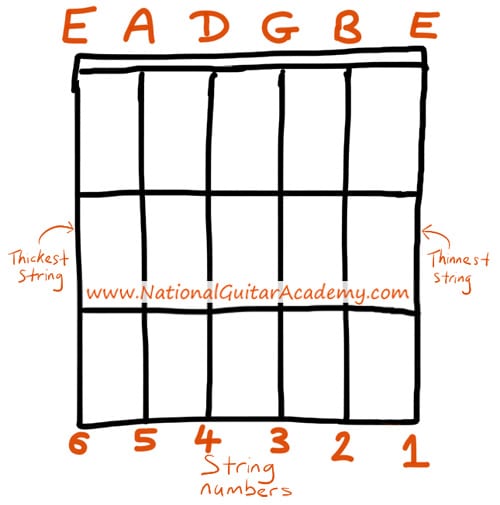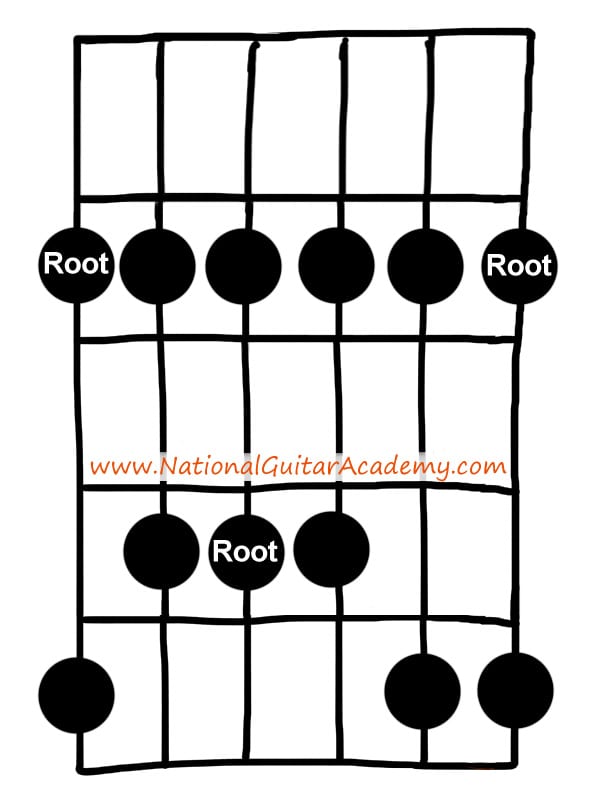Learn guitar scales in 8 easy steps with this free National Guitar Academy guide. (If you enjoy this article, check out our Master Guide: How To Play Lead Guitar.)
In this free guitar lesson, we’ll cover 8 steps…
Guitar scales decoded: A simple explanation, at last! 🙂
- Step 1: Understand the basics
- Step 2: The Major Scale
- Step 3: The Minor Scale
- Step 4: The Major Pentatonic Scale
- Step 5: The Minor Pentatonic Scale
- Step 6: The Blues Scale
- Step 7: Learn how to diagnose keys
- Step 8: Understand the huge importance of root notes
(If you just want an easy scale to solo with, scroll down & read about the Minor Pentatonic Scale. If you’re going to learn scales properly, read on.)
So, why learn guitar scales?
Ok, let’s dive in!
Over 100,000 guitar-learners get our world-class guitar tips & tutorials sent straight to their inbox: Click here to join them
.
Scales cause a lot of confusion for guitar learners, so we must clarify a few things before looking at the different scale patterns.
Why is it important to learn guitar scales?
Scales are the foundation of all lead guitar work and make it easy for you to crank out awesome single-note melodies.
When people learn scales, they unwittingly cross a ‘bridge’ and start understanding music theory. This makes you a significantly better guitarist because you begin to understand the instrument truly.
When should I learn guitar scales?
It’s never too early or too late on learning scales. They are beneficial to know at any stage of your guitar journey.
I prefer total beginners to focus on guitar chords, but I would never discourage anyone who wants to learn guitar scales from doing so. This is valuable stuff.
.
Ok, so what is a scale?
A scale is a series of steps between two fixed musical points. These two fixed points are always the same note but in different octaves. We call these points “root notes”.
How we get from the lower root note to the higher root note is called ‘a scale’.
Listen to this example. (I use two G notes in this example, but it could be any note. The principle remains true for ALL musical notes.)
Audio Player
.
Download our lead guitar cheat-sheet to make things easier
It's hard to understand which scales work with which keys.
So we created a cheat-sheet! A key and scale-finder that you can use again and again.

Get your personalised guitar-learning plan 🎸
Get a custom guitar-learning plan here: Click here for GuitarMetrics™
World-Class Guitar Courses 🌎
Learn from the world's best guitar educators: Click here for our guitar courses
Guitar scales are basically just ‘patterns of notes’
You could play 12 notes between the lower root note and the higher root note. (This is a full octave.)
- Think of it as a ladder with 12 ‘rungs’. The ladder represents the octave.
- The 1st and 12th rung are always there, always in the same place, but the rungs pattern can change.
- The pattern of the rungs on the ladder represents the different scale patterns.
Because there are 12 ‘rungs’ (AKA ‘notes’), we can choose to combine lots of different patterns and permutations.
I often see people trying to practise scales overwhelmed by the number of patterns, but thankfully it’s straightforward.
There are only a couple of scale patterns that 99% of guitarists need to know, and we will run through them here.
Can you read chord & scale diagrams?
To understand what’s coming next, you need to be able to read chord diagrams (AKA ‘chord boxes’).
If you can’t do this yet, read this article: How To Read Chord Boxes In 60 Seconds
All of the scale diagrams in this guide follow this layout:
Ok, you came here to practise scales on the guitar, so let’s look at our first scale! 🙂
The Major Scale
It is essential to understand how this scale works because its pattern is the yardstick by which we describe any other musical sound.
Every chord and scale is named by how it compares to this scale. This is the best starting point if you want to practise guitar scales.
Moreover, it is a bright and happy sounding scale. It’s uplifting, sweet and optimistic.
Box 1 of the major scale looks like this (we’ll talk about ‘boxes’ later on):
Did you spot the three root notes here? Well done! Like most other scale boxes, this one covers TWO OCTAVES.
Scales are moveable patterns
A crucial point you must know while knowing scales is that scale patterns are MOVEABLE.
What dictates the tonality of the scale is where you BEGIN playing it.
If you start playing the above pattern on the 5th fret (so the root note on the left is on the 5th fret of the 6th string), you will be playing the A Major Scale.
If you play the same pattern from a starting position two frets higher (starting on the 7th fret), you will be playing the B Major Scale.
.
A scale’s root note is the hero note. Use it lots.
In every scale, there is a root note. The root note is what names the scale. In the A Minor Pentatonic Scale, the root note is A.
In the E Major Scale, the root note is E.
The root note is the hero note. It’s the note that will sound best and give a sense of resolution to the riffs, licks and solos that you play. Finish your phrases on the root note to make what you played sound ‘right’.
The Minor Scale
The other scale you must know if you want to learn scales is the Minor Scale.
There are three different types of minor scales:
- The Natural Minor Scale (you must know this scale)
- The Harmonic Minor Scale (this is an incredible scale, and it would be good if you learn this, but it’s not essential)
- The Melodic Minor Scale (you don’t need to know this scale)
When people talk about “the minor scale”, they almost always refer to the Natural Minor Scale. That’s the ‘main’ version of these three minor scales.
The Minor Scale is much cooler than the Major Scale
The Natural Minor Scale provides a counterpoint to the Major Scale. If you’re playing scales, you need to understand the mood they create. This scale sounds sad and melancholy, and the contrast from the Major Scale is stark.
But of course, we need both! (Yin and Yang. Light and dark. Batman and the Joker, etc.!)
I think the Natural Minor Scale is much cooler than the Major Scale. It sounds more interesting and evocative.
But perhaps best of all, it gives us the foundation for the Minor Pentatonic Scale and Blues Scale, which are the most fun scales for most guitarists. (We’ll cover both of these scales later in this guide.)
Clearly, I’m not alone in liking the Natural Minor Scale because this scale provides the foundation for almost all rock and blues lead guitars. (Playing a solo on a minor scale over major chords just sounds fantastic. I’ve been doing it for years, and it gets more and more fun as time goes by!)
The Natural Minor Scale looks like this:
Technically, this scale ‘ends’ on the root note at the right, but people tend to add on the two notes on the far right. (These notes are from the start of the next octave.) I use all of these notes because they all sound good.
The Harmonic Minor Scale
This is only a little bit different to the Natural Minor Scale. Here we sharpen the penultimate note to make the pullback to the root note.
This creates an exotic-sounding 3-step interval. Try it!
Top tip: When soloing, you can blend these two minor scales and play a ‘hybrid’ scale like this:
.
The Melodic Minor Scale
In more traditional forms of music, that 3-step interval isn’t welcome. So we add an extra note to smooth the ascension. This creates the ‘melodic minor scale’. (AKA Jazz Melodic Minor Scale.) It looks like this:
Unless you want to learn jazz, this is a pretty niche scale. Most guitarists won’t need to know it.
Major and Minor Pentatonic Scales
So far we’ve covered the two pillars of music scale theory: the Major Scale and the Minor Scale.
These two scales are fundamental and you need to be aware of them, but most intermediate guitarists play these two scales in a simpler and abridged form.
The Major Pentatonic Scale is the Major Scale in abridged form.
So instead of playing the full major scale pattern like this:
The Major Scale
We play a simpler version, like this:
The Major Pentatonic Scale
Can you see that we simply removed two notes from each octave? (4 notes in total.)
I often see guitar learners mistake thinking the Major Scale is a totally different scale from the Major Pentatonic Scale. No, the Major Pentatonic Scale IS the Major Scale, just in a simpler form.
Similarly, the Minor Pentatonic Scale is the Minor Scale in abridged form.
So instead of playing this:
The Natural Minor Scale
We play this:
The Minor Pentatonic Scale
Can you see how all we’ve done here is remove two notes from each octave? (4 notes removed in total.)
So if you learn how to play the Major Scale and the Minor Scale, you already ‘know’ how to play their pentatonic versions. You just need to get accustomed to leaving those two notes out in each octave.
Box 1 of the Major Pentatonic Scale looks like this:
This isn’t the easiest scale to solo, so most intermediate guitarists use box 1 of the Minor Pentatonic Scale for most of their lead guitar work.
If you take only one thing away from this lesson, it should be to learn this pattern:
Minor Pentatonic Scale (Box 1)
The Minor Pentatonic Scale is the best scale to learn if you want to learn scales to play solos and lead guitar.
In a moment, we’ll look at one of the coolest scales of all, the Blues Scale. Before we do, let’s have a quick chat about ‘boxes’. (If you’re playing scales, you need to know this.)
.
Want free guitar tips and video lessons delivered to your inbox?
Join over 100,000 guitar learners and subscribe to our guitar-tips-by-email service. (It's free.)
We'll send you a series of lessons that will move you to the next level of your guitar journey.
Learn how everything fits together quickly, easily and effectively. We share ninja tips (for instant fun!) but also timeless fundamentals that will deepen your understanding.
Our Guitar Courses
To become a better guitarist click here to see our guitar courses
Get your personalised guitar-learning plan 🎸
Want us to make a guitar-learning plan that is customised to you? Click here for GuitarMetrics™
Get our best guitar tips & videos
Where should we send it?
Get our best guitar tips & videos



